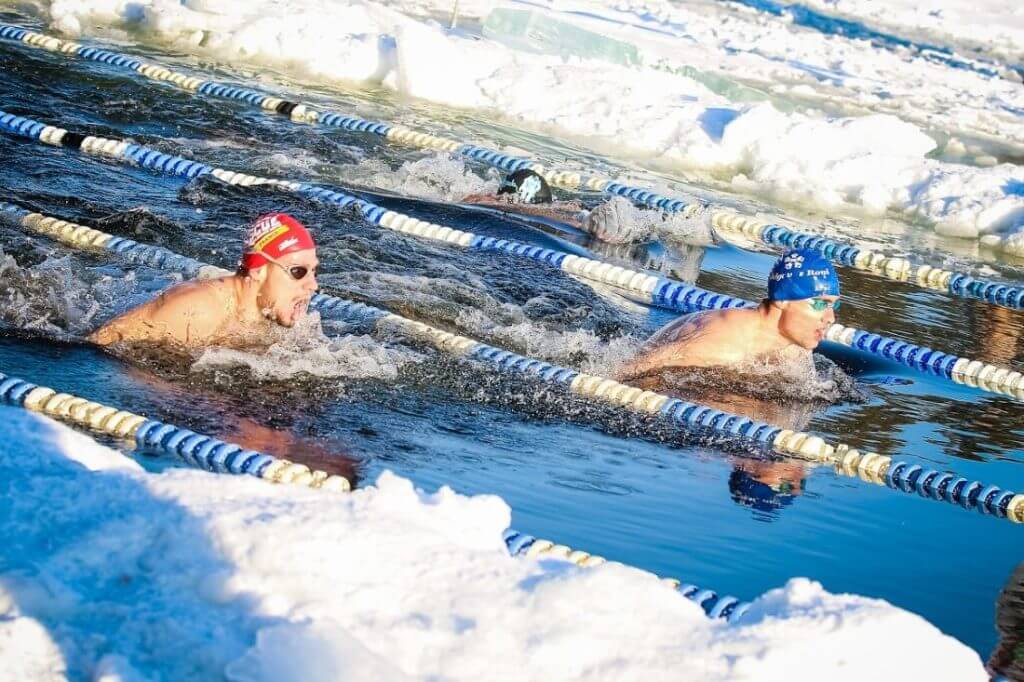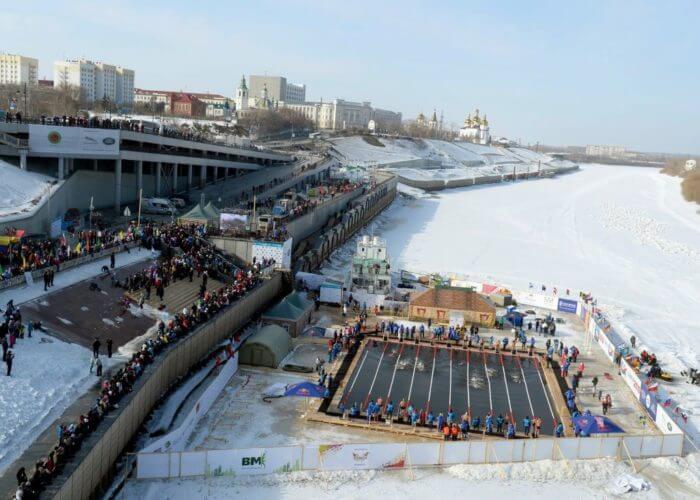Ice Swimming: An Extreme Challenge In Temperatures Difficult to Fathom

Ice Swimming: An Extreme Challenge In Temperatures Difficult to Fathom
Ice swimming is the fastest growing extreme aquatic sport. Tens of thousands of swimmers now hit the cold water daily and before the COVID restrictions, thousands traveled to events from Siberia to Argentina to Antarctica to the mountains of California and the loughs of Ireland.
History
Dipping in ice water has historic roots across the northern countries from Iceland to Japan. It was part of a sauna routine – but not really “swimming.” There were several key milestones that contributed to the sport’s emergence. Lynne Cox** executed a well-publicized swim 2.2 miles/3.5 km across the Bering Sea between Russia and the USA in 1987 in 4°C/40°F water at the height of the Cold War and 1.4 miles/2.25 km documented in her New York Times bestseller book “Swimming to Antarctica” in 2002 in 0°C/32°F water. Winter swimming in the northern countries held its first world championship in Finland in 2000. Later, Lewis Pugh* completed a 0.62 mile/1 km swim across the North Pole to highlight global warming in 2007 in -1.6°C/29°F waters. Yes, sea water has a lower freezing temperature!
The sport grew quickly as two organizations formed to coordinate events and drive safety standards: International Winter Swimming Association (2006) and International Ice Swimming Association (2009). They have contributed to an open water swimming season extending through the winters in both the Northern and Southern hemispheres.
What is it?

Photo Courtesy:
Ice Swimming is an extreme sport and, therefore, the swimmer tackles the cold waters in just a small swimsuit and cap (both non-neoprene) and goggles. Water temperatures vary depending on the challenge, ranging from below 0°C/32°F to whatever swimmers might find at a world championship in a majestic location like Lake Bled in Slovenia. And yes, wind chill can magnify the challenge. The swims take place in open-air pools, lakes, seas, rivers and often in a course cut into the surface ice (pictured Tyumen, Siberia in Russia – frozen river).
Marathon swimmers face longer swims (in excess of 20 miles/32 km) across the English Channel. The waters are cold, ranging from 8-19°C/46-66°F, but far from ice swimming.
Why?
Individuals are pushing physical and psychological limits in all sports and this draws swimmers to the cold water. For traditional pool swimmers, a serious cold-water challenge starts at 15°C/59°F water temperature. Then it all changes. Every degree drop from that level presents a very different challenge. 7.5°C is not twice as difficult as 15°C. It is a different world and 0°C is not of this world!
Training sessions are shorter and the key is to acclimatize to the cold water – getting your body and brain to accept it. Some will sit in a giant ice bath to prepare and visualize. All swimmers then set goals: Faster times, longer in the water, representing their country on a trip to Siberia for a world championship with friends, earning and walking about in the red “ice miler” jacket and even “enjoying” the esprit de corps that comes out of “common suffering” and achievement.
Range of Events
The sport presents a range of events and challenges. There are age-group competitions with 50/100 meter races with all the strokes (see pictured) and annual point competitions. These events may also allow a step up to a 450-meter “endurance” swim. Other events push the distance out to 1 km with recorded age group and overall world records. Stars from the pool and marathon world, including three time Olympian Petar Stoychev***, have driven down these record times. Many prefer team challenges like the Bering Strait Relay****: 66 swimmers from 16 countries completed the swim in a chilly six-day adventure.
Individual challenges kick in below 5°C/41°F with an ice mile – about 620 recorded to date. Complete one on every continent and join Jaimie Monahan* with the Ice7 badge. Drop down below 1°C/33.8°F and that mile earns the badge of “ice zero” – only 21 recorded to date. Then vary the location: Arctic (highest latitude), Antarctica (lowest latitude), Mount Everest (highest altitude), etc. And don’t forget swimming under the ice!
Safety
In all extreme sports, safety protocols develop steadily as knowledge increases. Needless to say, the main danger is hypothermia – when a swimmer’s core body temperature falls below a certain level and organ failure can result.
One of the unique elements of the sport and hypothermia is called “the drop.” The swimmer’s core body temperature continues to drop even after they exit the water and start the warming process. Research enables safety teams to look for signals that a swimmer is approaching trouble and to end their swims early and safely. The sport dives safe practices: Complete medical checks in advance, never swim alone, build up gradually, breathe slowly/don’t hyperventilate, get out before hitting trouble, dry off – get warm layers on as fast as possible, rewarm slowly, push starts, open turns and NEVER jump into a hot shower or hot tub afterward.
As for the future, more swimmers, more events, more challenges and perhaps the Winter Olympics are being targeted. For the pool swimmers reading this article, who already own the required equipment, see you in the ice soon.
*Honoree of the International Marathon Swimming Hall of Fame (IMSHOF) and Ice Swimming Hall of Fame
**Honoree of the International Swimming Hall of Fame and IMSHOF
***Honoree of all three Hall of Fames
****Honoree of the Ice Swimming Hall of Fame



